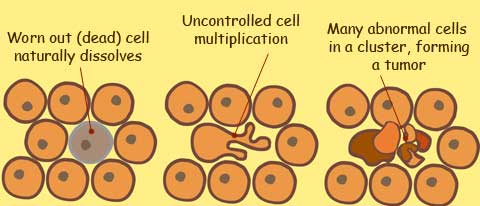 |
What is cancer, and how does it develop?
The organs in our body are made up of cells. Cells don’t just appear from anywhere in our body. They are produced by an existing cell copying itself and splitting to produce two new cells. This is called cell cycle. This cycle is tightly controlled and it only happens if the body needs to replace worn out cells. When these cells continue multiplying even when the body doesn't need them, the result is a mass or growth, also called a tumor.
Illustration of normal cells dividing

Illustration of uncontrolled multiplication of abnormal cells
These growths are considered either benign or malignant. Benign is considered non-cancerous and malignant is cancerous.
Benign tumors rarely are life threatening and do not spread to other parts of the body. They can often be removed.
Malignant tumors, however, often invade nearby tissue and organs, spreading the disease.
Cancer can be life threatening. The key is in early diagnosis. If cancer is diagnosed early, there is a high chance that cancer can be completely cured.
How Does Cancer Spread to
Other Parts of the Body?
The cells within malignant tumors have the ability to invade neighboring tissues and organs, thus spreading the disease. It is also possible for cancerous cells to break free from the tumor site and enter the bloodstream, spreading the disease to other organs. This process of spreading is called metastasis.

|
 |
